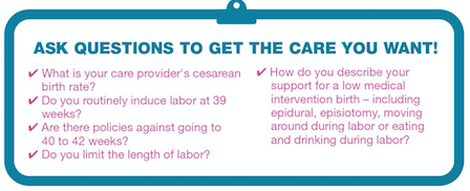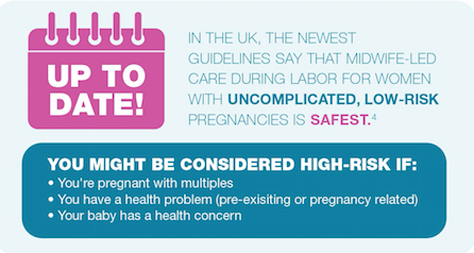Choosing a Pregnancy and Birth Health Care Provider - New Infographic from Lamaze International
By: Sharon Muza, BS, LCCE, FACCE, CD/BDT(DONA), CLE | 0 Comments
 Most families have already chosen a health care provider by the time they find themselves in childbirth classes. The exception might be those educators who reach families at the beginning of their pregnancies by offering an early pregnancy class that includes this topic. Most families begin their childbirth class experience close to, if not in, the third trimester. By that time, many pregnant people have chosen their pregnancy and birth provider months before. They made their choice because they received gynecological care from them prior to pregnancy, a particular doctor or midwife was on their medical insurance panel or their friend or family member had used them. Some families do a lot of research before making this choice, but many families do not.
Most families have already chosen a health care provider by the time they find themselves in childbirth classes. The exception might be those educators who reach families at the beginning of their pregnancies by offering an early pregnancy class that includes this topic. Most families begin their childbirth class experience close to, if not in, the third trimester. By that time, many pregnant people have chosen their pregnancy and birth provider months before. They made their choice because they received gynecological care from them prior to pregnancy, a particular doctor or midwife was on their medical insurance panel or their friend or family member had used them. Some families do a lot of research before making this choice, but many families do not.
 newest infographic provides resources and information to help families understand that selecting a health care provider is an important decision and not one to be taken lightly. The infographic also explains how the midwifery model of care is often a good choice for healthy, low risk pregnant people. 85% of all pregnant people are considered low risk. There are conditions that would risk out a person from midwifery care, and should that happen during the prenatal or intrapartum period, the midwife will refer appropriately to a physician. This helpful infographic discusses the different types of maternity care providers and offers questions to use as a guide when selecting health care providers to work with.
newest infographic provides resources and information to help families understand that selecting a health care provider is an important decision and not one to be taken lightly. The infographic also explains how the midwifery model of care is often a good choice for healthy, low risk pregnant people. 85% of all pregnant people are considered low risk. There are conditions that would risk out a person from midwifery care, and should that happen during the prenatal or intrapartum period, the midwife will refer appropriately to a physician. This helpful infographic discusses the different types of maternity care providers and offers questions to use as a guide when selecting health care providers to work with.
In addition to this infographic, Lamaze International offers a free online early pregnancy class - 'Prepared for Pregnancy: Start off Right' that families can work through. This interactive e-learning course covers important topics that families should be considering and learning about in the first weeks of pregnancy, often before they have even had their first prenatal appointment with their health care provider. You are invited to try out this course as well, so that you can recommend it to the 'just pregnant' families that you connect with.
 As a birth professional, you can help families find a health care provider who is a good fit for their desires and preferences. Helping them to understand what good care looks like, and providing them resources to identify a doctor or midwife who practice style aligns with their wishes can help them achieve a safe and healthy birth. Letting them know that it is never too late to switch health care providers, even if they are just days away from their birth. I asked some families to share with me their experiences in switching to a more compatible health care provider during a pregnancy, and here is what they said:
As a birth professional, you can help families find a health care provider who is a good fit for their desires and preferences. Helping them to understand what good care looks like, and providing them resources to identify a doctor or midwife who practice style aligns with their wishes can help them achieve a safe and healthy birth. Letting them know that it is never too late to switch health care providers, even if they are just days away from their birth. I asked some families to share with me their experiences in switching to a more compatible health care provider during a pregnancy, and here is what they said:
'When we wrote up our birth plan, one provider read through it and condescendingly asked what website we'd downloaded it from and brushed off our concerns - and ours was a very basic birth plan, evidence-based and realistic. After that and another incident a few weeks later involving fetal movement, it was pretty clear that this practice was probably not our best fit. I managed to get an appointment scheduled with my first choice CNM for 37w 5d. It was such a hard decision, even to get that far! Pregnancy hormones, feeling like I was disrupting or losing established relationships, even fear that the OB would be mad. Fortunately, the CNM was a perfect fit and we all knew it right away. We finished the appointment and immediately signed the paperwork to transfer care and records. Apparently my body and the baby were pleased, as baby was born less than two days later at 38 weeks exactly. We ended up having exactly the birth we wanted.' - ZV
********
'I changed providers in my third trimester. The constraints of the birth location were slowly whittling away at the family and doula support I anticipated needing. I opted for a licensed midwife who helped me birth at home, surrounded by the caring loved ones who helped make the experience safe and satisfying. It wasn't an easy choice, and we had to pay more, but the feelings and memories from that day I will always treasure.I know it was the right choice for our family.' - SB
********
'I switched from an OB to midwifery care after an early miscarriage. I was upset and my ob said, 'let's just keep this in perspective'. My perspective was that I needed a new care provider! - CM
********
'I switched providers at 8 weeks. My OB said her office does not do VBACs. So I found another practice who did ' and it happened to be with a midwife. I didn't think I was the midwife type but I really wanted a VBAC. And I had a great one!' - SW
********
'For my second child, I had originally gone back to the same OB I used during my first pregnancy (and subsequent miscarriage). I hadn't been entirely happy with the way I had been treated the first go-round, but I was familiar with him and liked the hospital he delivered at. Just after my 19 week ultrasound, however, I finally got tired of being ignored and belittled during my appointments. I scheduled an appointment with a midwife at a nearby birth center, took a tour, and never looked back. Being cared for by midwives was the best decision I have ever made. At the birth center, I never felt like I was just another file. They knew me, knew my family, and took the time to make sure I was getting my questions answered and my concerns were addressed immediately ' I was never made to feel stupid for anything I said or asked about. My birth experience was 100 times better. Switching at 21 weeks pregnant was, no question, the best thing I could have done.'- JD
********
'I switched providers at 34 weeks. I switched for a few reasons, but mostly the midwifery practice seemed very standardized and cold not as personal as the practice I delivered with previously. I made the decision to switch, saw my new midwifery group only twice and delivered at 37w4d. I was very pleased with my experience with the new practice.' - TNM
********
'I switched providers two times during my pregnancy. I had an unusual health history and wanted a birth with the least interventions possible. Despite being upfront about my history with everyone I spoke with, I kept losing practitioners who felt I was too high risk to them to care for. I felt my birthing goals slipping further and further away every time this happened. It was only after I realized I was spending every single appointment crying that I decided that I needed to let some things go. I made my final switch, choosing my family practice doctor who also did babies. I realized that the most important thing was to have a good relationship with a provider I trusted, who respected my goals, and who didn't have me in tears after every appointment. This change meant I had to change the hospital I chose to birth at to the one in the area with the highest rate of interventions, but I could not spend the remainder of my pregnancy under such extreme stress. Less interventions would be best for my son, but having a mother who wasn't feeling threatened at every turn would help as well. I get tearful now, over eight years later, writing about it. In the end, I did get the interventions I didn't want, but only after my provider let me push it as far as possible. She respected my goals. It was the right choice but incredibly challenging to face having to change and losing trust over and over. I felt abandoned by too many people at a time when I was very vulnerable.' - SD
Birth professionals can find all the useful infographics here and share the parent infographics page with the families you work with. Parents can find the new infographic on choosing a provider here on the parent website. Choosing a care provider is an important part of having a safe and satisfying birth experience. Childbirth educators and professionals are in a unique position to support families as they navigate their choices and make decisions that can help them reach their goal of a healthy and safe birth, baby and parent. For a very detailed guide to questions to ask a care provider, I find the Choices in Childbirth National Guide to a Healthy Birth to have a very comprehensive list of questions for families to rely on. The list can be found on page 10 of this brochure.
Lamaze International continues to support professionals and educators with infographics and tools to help families navigate their pregnancy and birth and work toward healthy outcomes. This new infographic on 'Choosing a Care Provider' is another excellent tool that is available for you and consumers. Thanks Lamaze!
Published: October 21, 2015
Tags
PregnancyChildbirth educationEarly pregnancyInfant SafetyProfessional ResourcesMaternal Infant CareMaternal SafetyEvidence Based TeachingParent educationInfographicsCommunity HealthPublic HealthChoosing A ProviderOnline Learning